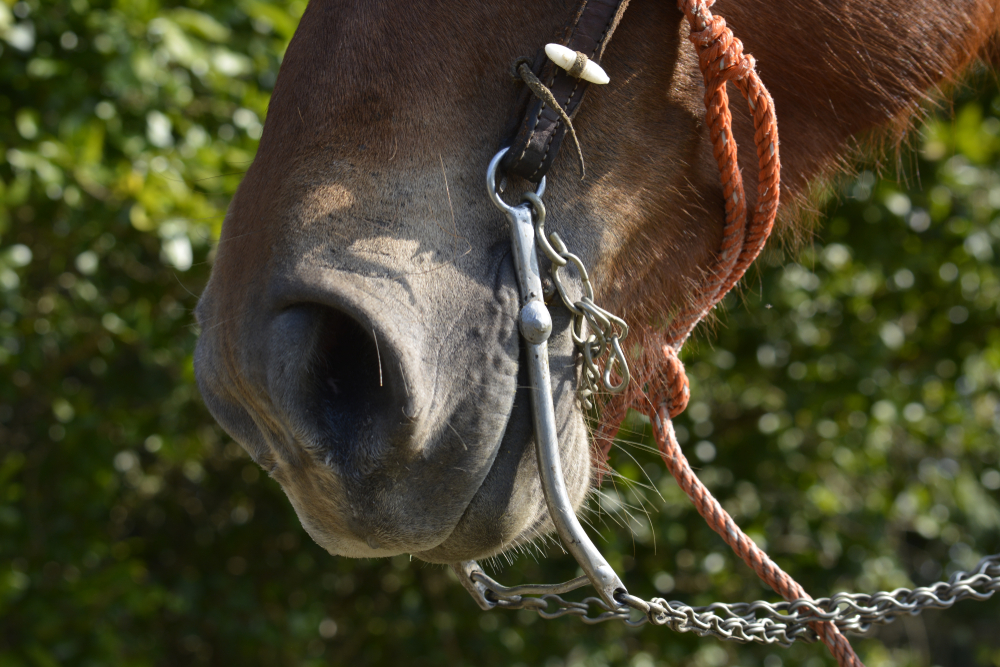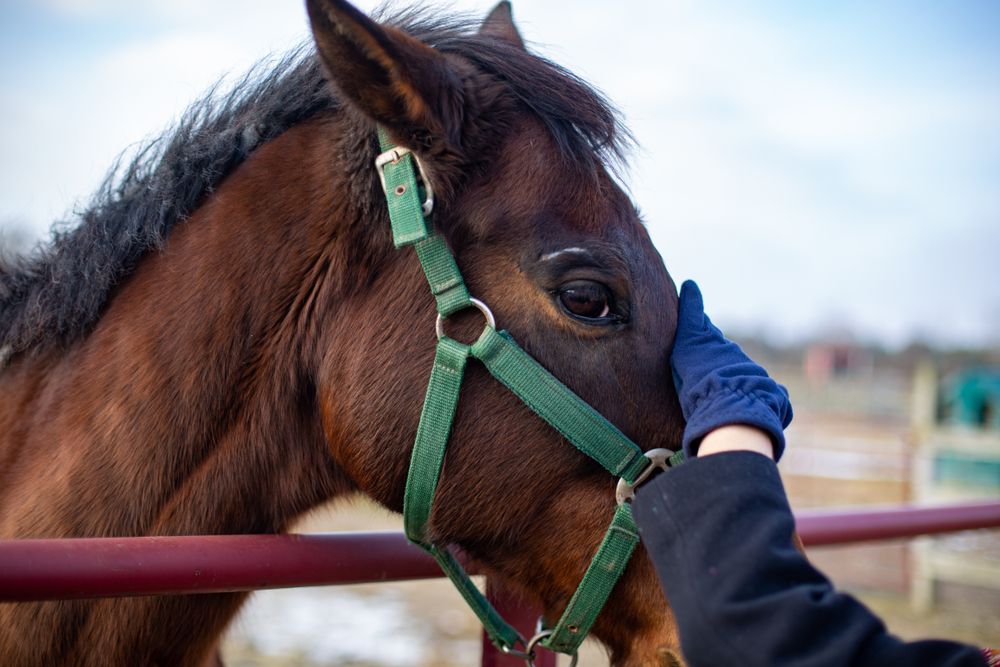- Your source for stall mats, rubber arena footing, arena harrows and arena dust control.

Horse riding seems to come with its own complex language. The terms can boggle the mind: crupper, eggbutt French link, fender, frog, gymkhana, and pelham, to name a few. Even once you get used to the terminology, another new word is tossed in, leaving you scratching your head. Take the hackamore: What is it, and what is it used for?
Hackamores are a grouping of bitless bridles that is used to direct a horse. Generally, bridles come with a bit, a piece of metal that sits in the horse’s mouth. Hackamores use pressure outside of the mouth. There are three main categories: bosal hackamores, mechanical hackamores, and sidepulls.
Hackamores are championed as a kinder way to ride horses. There is no metal in the horse’s mouth, which is especially nice if the horse has dental issues, and some feel it is a more natural way to ride. However, not everyone is a fan. Even those that do ride bitless scorn some hackamores.
How a Hackamore Works
Hackamores, also called bitless bridles, work with pressure on the outside of the horse’s face. This is different to a bit which puts pressure on the inside of the horse’s mouth. They are often used when a horse is young, but they are also helpful for horses with sensitive mouths and dental issues.
The objective of a hackamore is to use pressure and release. When a rider has an “ask,” the pressure is applied. When the horse “answers,” the rider releases the pressure. Hackamores are not designed for constant pressure or a rider with hard hands. The release is essential for proper communication between rider and horse.
Parts of a Hackamore
- The hanger, or headstall,
 or poll is the piece that goes over the horse’s head and behind the ears.
or poll is the piece that goes over the horse’s head and behind the ears. - The mecate, or reins, is the part that a rider holds.
- The bosal
 is the piece going around the horse’s nose and is knotted under the horse’s chin. The knot is known as a “heel knot.”
is the piece going around the horse’s nose and is knotted under the horse’s chin. The knot is known as a “heel knot.” - Fiador
 , or a Theodore, is what looks like a throat latch. It fastens to the heel knot, keeping the bosal in place.
, or a Theodore, is what looks like a throat latch. It fastens to the heel knot, keeping the bosal in place.
Three Main Types of Hackamore
Hackamores come in various styles and sizes, but they fall into three main types: bosal hackamores, mechanical hackamores, and sidepulls.
Bosal Hackamore
Bosals are known for their specific nosepiece, often made of braided rawhide and secured by a knot. It was introduced to horse riding in the 1800s by the California vaqueros, who were cowboys with Spanish roots. Consequently, the bosal is popular with western riders.
This YouTube video explains the bosal and how to fit it properly:
Mechanical Hackamore
Mechanical hackamores have shanks. The noseband can also be uncomfortable for the horse. There is a chain that goes under the horse’s chin also to provide pressure. Together, the pieces “pinch” the jaw. The purpose of a mechanical hackamore is to provide “breaks” for the rider.
It is incredibly easy to cause damage to a horse with a mechanical hackamore. Care needs to be taken and they are poorly suited for a beginner rider. This is also a poor tool to teach a horse bending or flexing. Horses will stop pretty easily in a mechanical hackamore, but other communication is lacking with this tool.
This in-depth YouTube video explains the different types of mechanical hackamores. It also goes through the pros and cons of the mechanical hackamore and how they compare to training with a snaffle:
Sidepull
Sidepulls are a type of hackamore that goes by many names such as cavesson, Lindell, and Scrawbridge. The pressure from a sidepull is put on the horse’s muzzle. A sidepull allows communication for both slowing and turning.
These can be a kinder option, but not always. Some are made of thin, stiff rope, with strategically placed knots that can, in the wrong hands, create injury to the horse. There are a large variety of options, however, including those made of padded leather.
This YouTube video discusses riding with a sidepull:
Other Types of Hackamores and Bitless Bridles
Bitless bridles are often variations, mergers, or tweaks of the traditional hackamores. But through their evolution, some of these are now considered their own style of bridle. Here are three popular types of bitless bridles.
Cross-Under
A cross under bitless bridle spreads the pressure around the head. Some describe the feeling as a “head-hug” to the horse. The advantage is that the pressure isn’t in one spot, limiting the risk of a horse developing sores.
The most famous of the cross-under style is the original: Dr. Cook Bitless Bridle . Many other bitless bridles are variations of Dr. Cook’s “head-hug” concept.
. Many other bitless bridles are variations of Dr. Cook’s “head-hug” concept.
Jumping Hackamore
The jumping hackamore is a variation on the sidepull. It uses no leverage and tends to be made of padded leather. The communication is meant to be soft.
is a variation on the sidepull. It uses no leverage and tends to be made of padded leather. The communication is meant to be soft.
Wheel Hackamore, Flower Hackamore, Star Wheel Hackamore
The wheel bridles come with a metal wheel, flower, or star that sits just about the sides of the mouth. Some refuse to call themselves hackamores at all; others proudly strut the category. They are popular in Europe and considered to provide more control than a sidepull but much softer than a mechanical hackamore. A much-loved version is the LG bridle .
.

Arguments for and Against Hackamores and Bitless Bridles
If you ever want to start a major argument in the equestrian world, bring up bitless bridles. Some people love them, preach about them, and think using anything else is cruel. Then there are those on the side of bits who say they’ve never seen a horse so hurt and damaged than one in a bitless bridle.
Here is a list of commonly argued pros and cons to riding without a bit. Of course, if you agree with the proponents or the naysayers is an entirely different matter.
Arguments for Bitless Riding
- Great for a horse with mouth or dental issues.
- A more natural way to ride a horse.
- More comfortable for the horse.
- A kinder way to ride.
- Increased stopping power.
- Certain models are good for training.
- Won’t give a horse a “hard mouth.”
- Won’t sour or ruin a horse.
Arguments Against Bitless Riding
- Lack of control.
- Can create pain and sores on the horse’s face.
- Can damage and or wreck a horse’s face.
- Are not allowed in certain riding disciplines.
- Are harder to get a proper fit.
- Poor communication between rider and horse and result in less finesse.
- They can sour or ruin a horse.
What Both Sides Have in Common
Two things common between each side of the debate are their thoughts on the horse and rider.
The first is relatively simple: some horses are more sensitive to some equipment than others. If a horse has a bad mouth, a bit might be awful. Other horses can’t stand the “hug” of a bitless bridle. Whatever option you pick, it should consider your horse’s needs.
The second matter both sides agree on is that the best way not to hurt your horse is to ride well. Riders that use constant, harsh pressure are going to hurt the horse, regardless if they are using a bit or not. A rider’s faults can be softened or heightened depending on the gear. So it is good to be honest about the rider’s weaknesses and choose equipment that will lessen the chances of a horse being injured.
Even better, get some quality training to correct those rider errors. Good training is as necessary for the rider as it is for the horse.
Lastly, here is a YouTube video to walk you through various bitless bridles and their overall pros and cons:
Conclusion
Hackamores and bitless bridles have their place in the equestrian world. However, like most topics in horse riding, there are debates on which are best and when they should be used, if ever. Regardless where you all in the debate, the most important thing you can do for your horse is to learn to ride well.
Sources
https://www.thesprucepets.com/all-about-mechanical-hackamores-1886064
http://www.horse-advice.com/equi-therapy/saddlery/hackamore-bridle.shtml
https://www.horseillustrated.com/horse-training-how-to-use-a-hackamore

